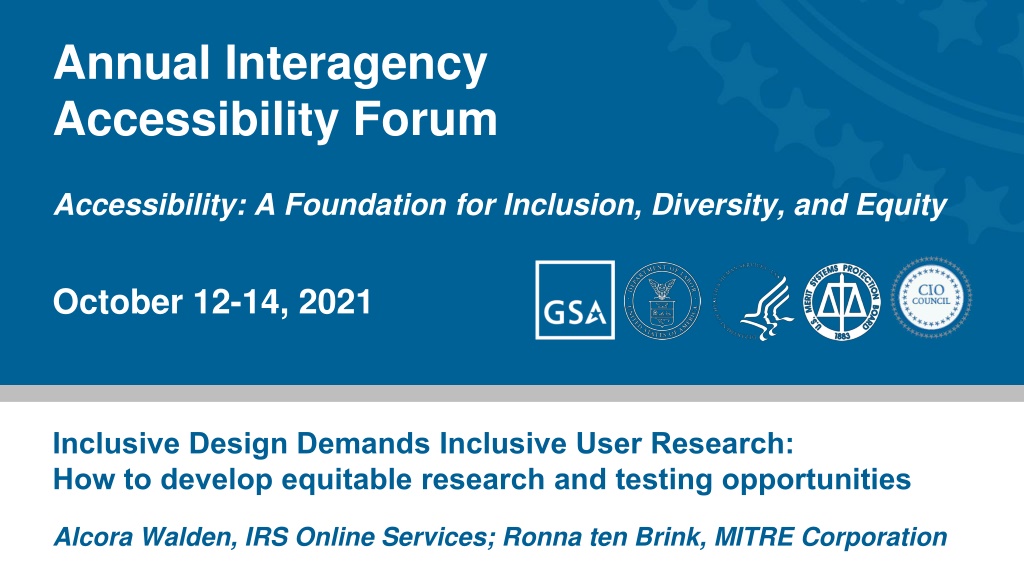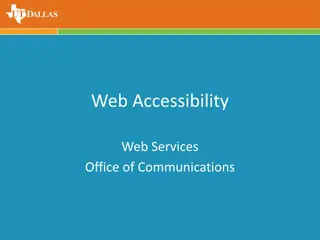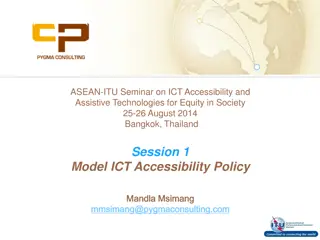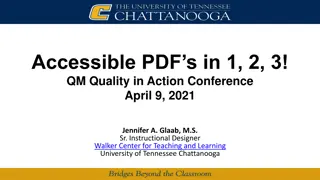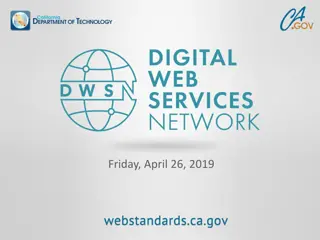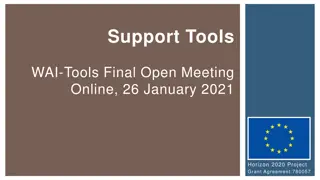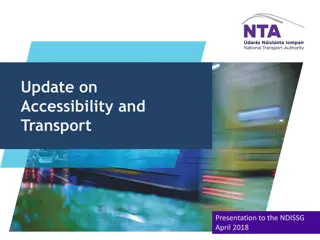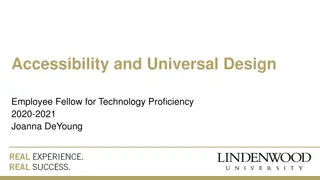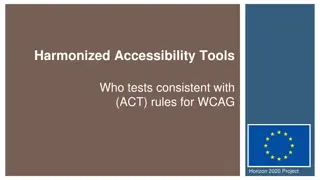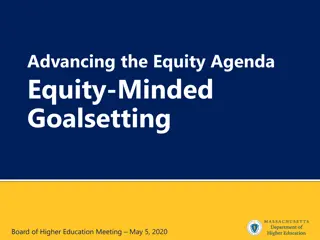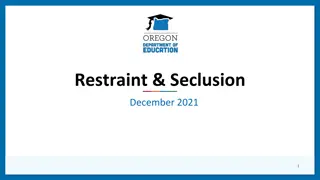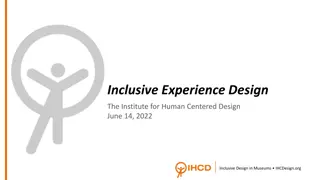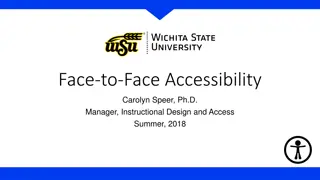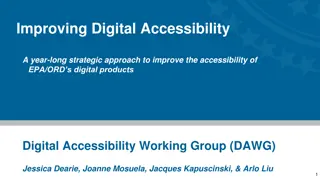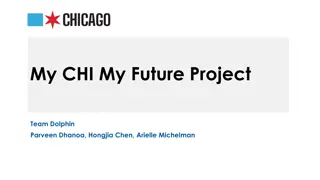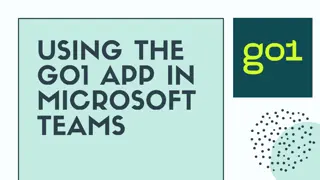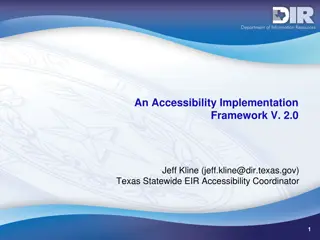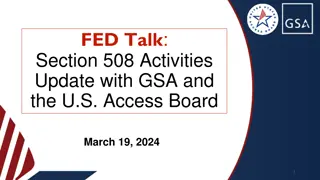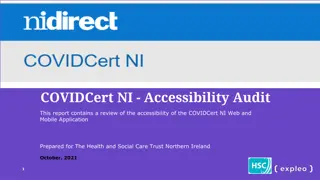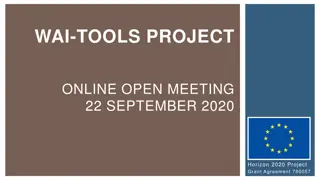Enhancing Inclusive User Research for Accessibility and Equity
Explore the journey of IRS Online Services in developing an inclusive user research capability to cater to underrepresented populations. Learn how inclusive design goes beyond compliance to foster diversity and usability for all, with a focus on prioritizing feedback opportunities for individuals with disabilities and limited English proficiency.
Download Presentation

Please find below an Image/Link to download the presentation.
The content on the website is provided AS IS for your information and personal use only. It may not be sold, licensed, or shared on other websites without obtaining consent from the author. Download presentation by click this link. If you encounter any issues during the download, it is possible that the publisher has removed the file from their server.
E N D
Presentation Transcript
Click to edit Master title style Annual Interagency Accessibility Forum Click to edit Subtitle Accessibility: A Foundation for Inclusion, Diversity, and Equity October 12-14, 2021 Inclusive Design Demands Inclusive User Research : How to develop equitable research and testing opportunities Alcora Walden, IRS Online Services; Ronna ten Brink, MITRE Corporation
Our Presentation Today We ll be talking about: Background and motivations The Inclusive Research capability maturity model and roadmap we re developing Some practical tips for conducting user research with participants with disabilities (PWD) IAAF 2021 / General Services Administration / Department of Health and Human Services / Department of Labor / Merit Service Protection Board / Sponsored by the Federal CIO Council 2
Background IRS Online Services (OLS) is the digital touchpoint for the millions of Americans that IRS serves OLS realized that underrepresented populations aren t explicitly included in the R&D process So, OLS is building an inclusive user research and usability capability to expand research opportunities to new and diverse taxpayer populations Current focus: Identifying and prioritizing research and feedback opportunities for taxpayers with disabilities and taxpayers with limited English proficiency IAAF 2021 / General Services Administration / Department of Health and Human Services / Department of Labor / Merit Service Protection Board / Sponsored by the Federal CIO Council 3
The Inclusive Design Mindset Inclusive Design is a methodology, born out of digital environments, that enables and draws on the full range of human diversity. Most importantly, this means including and learning from people with a range of perspectives. - Microsoft Inclusive Design IAAF 2021 / General Services Administration / Department of Health and Human Services / Department of Labor / Merit Service Protection Board / Sponsored by the Federal CIO Council 4
Accessibility Beyond Compliance Accessibility isn t a checklist. Inclusive Research isn t the same as standards compliance. Creating an Inclusive Research capability isn t the same as creating an Accessibility capability Why research with people with disabilities? 1. Support building accessibility in from the start 2. Diversify participants 3. Increase usability for all IAAF 2021 / General Services Administration / Department of Health and Human Services / Department of Labor / Merit Service Protection Board / Sponsored by the Federal CIO Council 5
Initial Goals Provide the wider IRS with Targeted user research and usability evaluation Expertise in design and evaluation in accessibility, multilingual services and Inclusive Design Identify and prioritize target applications, services and web content for usability research with target populations Monitor and increase the participation rate of target populations in OLS user and usability research IAAF 2021 / General Services Administration / Department of Health and Human Services / Department of Labor / Merit Service Protection Board / Sponsored by the Federal CIO Council 6
Growing Research Capabilities We re in the early stages of a multi-year process! Let s innovate to push the intersection of government UX and Accessibility forward We welcome ideas, feedback, and collaboration Usability and accessibility are twins separated at birth. Same goals but like two brothers in a fable, they took different paths What happens when these two meet? Can we get deep insights and great power? - Whitney Quesenbery, Better Accessibility Needs User Research (2015) IAAF 2021 / General Services Administration / Department of Health and Human Services / Department of Labor / Merit Service Protection Board / Sponsored by the Federal CIO Council 7
Inclusive Research Capability Maturity Model and Roadmap IAAF 2021 / General Services Administration / Department of Health and Human Services / Department of Labor / Merit Service Protection Board / Sponsored by the Federal CIO Council 8
Deliberately Growing our Inclusive Research Capability A piecemeal approach to inclusivity and accessibility can lead to inconsistent results, inefficient processes, difficulty securing needed resources, and unsustainable resources. We re creating an Inclusive Research Capability Maturity Model to: Measure and track the degree of maturity OLS reaches in managing and implementing inclusive research Identify future long- and short-term objectives and success metrics IAAF 2021 / General Services Administration / Department of Health and Human Services / Department of Labor / Merit Service Protection Board / Sponsored by the Federal CIO Council 9
Inclusive Research Capability Maturity Levels Level 1: Initial IAAF 2021 / General Services Administration / Department of Health and Human Services / Department of Labor / Merit Service Protection Board / Sponsored by the Federal CIO Council 10
A Roadmap to Climb the Maturity Model An associated roadmap will lay the path for how we ll grow our capabilities, and help to: Define the timeline Determine scope and progress metrics Articulate tasks-to-be-done and milestones along the timeline Identify dependencies, risk factors, and what resources will be needed Strategize for handling risk and ensuring the right resources are available We re currently scoping for 5 years. IAAF 2021 / General Services Administration / Department of Health and Human Services / Department of Labor / Merit Service Protection Board / Sponsored by the Federal CIO Council 11
Roadmap Subsets Operationalized research Contractors & procurement Workforce Sustainability Established community Overview IAAF 2021 / General Services Administration / Department of Health and Human Services / Department of Labor / Merit Service Protection Board / Sponsored by the Federal CIO Council 12
Roadmap Subset Details, 1/2 Operationalized Research Contractors & Procurement Workforce Equipping OLS researchers, designers, and management with Inclusive Research and accessibility skill sets Recruiting staff to bring further expertise to the team Planning, recruiting, collecting data, analysis, reporting Ethics, etiquette, interpretation, communication Accessible prototypes and study materials Accountability Building Inclusive Research into requirements Setting accountability mechanisms IAAF 2021 / General Services Administration / Department of Health and Human Services / Department of Labor / Merit Service Protection Board / Sponsored by the Federal CIO Council 13
Roadmap Subset Details, 2/2 Established Community Sustainability Overview Regularly measuring, auditing, and strategizing Creating accountability goals and consequences Handling auditing and remediation (of research practices and resources) Identifying and managing future risk Updating the Roadmap as needed this is a living document! Getting buy-in on Inclusive Research and accessibility Securing sustainable resourcing Assigning ownership Ensuring sustainability despite organizational change Creating relationships across organizations and agencies with others interested in Inclusive Design, accessibility, and user research (and multilingual) Sharing knowledge and resources where possible IAAF 2021 / General Services Administration / Department of Health and Human Services / Department of Labor / Merit Service Protection Board / Sponsored by the Federal CIO Council 14
Roadmap Metrics What gets measured, gets done Outcomes (Impact): How this will benefit taxpayers Success: Knowing the moment when we ve achieved outcomes Progress: Knowing how far we ve come towards achieving the outcome, and how far we have left to go. Includes milestones identified in advance and updated as we learn over time. Challenges: Discovering what prevents us from achieving outcomes, and how much those obstacles cost OLS if they accumulate. Metrics will also help us to: Prioritize future activities, based on value to users and effort to accomplish Demonstrate the value that solving these problems brings for the organization IAAF 2021 / General Services Administration / Department of Health and Human Services / Department of Labor / Merit Service Protection Board / Sponsored by the Federal CIO Council 15
Next Steps, 1/2 We re currently piloting studies with users with vision loss and other disabilities to grow our learning through doing. In future, we will: Set the stage for where we re starting. Review past OLS user research to learn if and how participants with disabilities have been included; and how OLS might currently be measuring our metrics of interest. Further operationalize the roadmap. Fill in the detail on those subsets, metrics, etc., and create useful artifacts. Gather more information on OLS s data repositories and processes to understand: What data is available to us? What data isn't currently available, but could be? How does that data relate to other data we already have? What untapped value within the data could we surface? IAAF 2021 / General Services Administration / Department of Health and Human Services / Department of Labor / Merit Service Protection Board / Sponsored by the Federal CIO Council 16
Next Steps, 2/2 In future, we will: (continued list) Expand our target participant groups. We want this capability to eventually include all types of disabilities: visual, auditory, cognitive, neurological, physical, speech, and multiple disabilities. Inclusive Research capabilities should grow as new accessibility areas develop, ex. trauma-informed services. This Inclusive Research should identify further underrepresented populations to explicitly include their voices in the development of services. Keep updating the roadmap with new developments. We re at the beginning of our journey. We d love to hear from you if you have advice, feedback, or want to talk more about these topics. IAAF 2021 / General Services Administration / Department of Health and Human Services / Department of Labor / Merit Service Protection Board / Sponsored by the Federal CIO Council 17
Practical Tips for Conducting User Research with Participants with Disabilities IAAF 2021 / General Services Administration / Department of Health and Human Services / Department of Labor / Merit Service Protection Board / Sponsored by the Federal CIO Council 18
Design your research inclusively from the beginning Designing research inclusively from the start is different from adapting existing research plans. It enables you to: Allocate the necessary resources ahead of time for working with PWD, rather than playing catch-up or cutting corners later Extra session time, potential extra effort recruiting, higher incentives to accommodate travel or connection efforts, training facilitators, etc. Create accessible prototypes, rather than remediate later Prevent accessibility issues in your execution plans that otherwise wouldn t be found until it s more costly or too late to address them Ask better questions to get better insights Inclusive Design: You ll get more universal perspective rather than narrow perspective, and likely end up building a more usable product IAAF 2021 / General Services Administration / Department of Health and Human Services / Department of Labor / Merit Service Protection Board / Sponsored by the Federal CIO Council 19
Audit your product for accessibility before user testing Build your digital service to be accessible, and audit it for accessibility before testing with PWD You wouldn t get high-quality insights from testing a page with dead links and broken elements and you won t get high-quality insights from testing a page that isn t reasonably accessible to start It s ok (and useful!) if participants discover one or two accessibility issues during testing. But your goal here is user research, not accessibility testing. Consider that a product might be accessible in a moderated session, but inaccessible with facilitator guidance Try to run moderated sessions first. If more data is needed to confirm results, then try unmoderated, and adapt your prototype or supporting materials to compensate IAAF 2021 / General Services Administration / Department of Health and Human Services / Department of Labor / Merit Service Protection Board / Sponsored by the Federal CIO Council 20
Make sessions themselves accessible and anticipate unknown needs All study materials and environments must be accessible Recruiting and screening; informed consent, signatures; getting to the session; supporting materials; the tasks themselves; the physical and/or digital test environment; incentive delivery Write materials in plain language and deliver in accessible formats and multiple formats Ask if your participant needs accommodations If there are certain accommodations you know you can t offer for the study (ex. American Sign Language interpretation), be upfront in recruiting so you don t waste a respondent s time Let participants use their own tech set-ups if possible Participants may have complex assistive tech (AT) set-ups or configurations that your lab computer can t support, or that would take too much time to set up. Besides, don t you want realistic sessions? Conduct technology checks or dry runs for virtual sessions Don t assume participants are tech savvy. Doing a dry run also helps in case session software doesn t interact well with assistive tech. Make sure the participant and study coordinator can quickly contact each other in case a participant needs assistance getting to the session (virtually or in real life) IAAF 2021 / General Services Administration / Department of Health and Human Services / Department of Labor / Merit Service Protection Board / Sponsored by the Federal CIO Council 21
Recruit and group along functional capabilities or AT usage Disability is a spectrum and differs for every individual. You ll likely get clearer and more reliable data recruiting and grouping along functional capabilities or AT usage, than along disability. For example, out of 5 folks who are legally blind, they may use technology in vastly different ways. The ways they use technology are more relevant to your research goals than how they label their vision level. Recruiting and grouping along disability names only may yield unanticipated and inconsistent participant samples IAAF 2021 / General Services Administration / Department of Health and Human Services / Department of Labor / Merit Service Protection Board / Sponsored by the Federal CIO Council 22
Beware unintentional screening You may be unintentionally screening out valuable participants through inaccessible, unappealing, or poorly targeted recruiting and screening Check if recruiting and screening methods, channels, formats, or tone might be screening out potential participants Don t ask more than you need to know; respect participants privacy Offer materials and payment in multiple formats and channels, ex. PDF, Word; Amazon gift card, pre-paid Visa card, money transfer, cash Write in plain language and follow appropriate etiquette and tone Do the extra legwork to find hard-to-reach participants identify relevant service organizations, community leaders, etc. that you could recruit through Compensate for additional barriers to participation Getting to your session can be more burdensome for PWD. Offer higher participant incentives to offset these burdens. IAAF 2021 / General Services Administration / Department of Health and Human Services / Department of Labor / Merit Service Protection Board / Sponsored by the Federal CIO Council 23
Anticipate fatigue and extra time Monitor participant fatigue and stress, and react accordingly Your tasks or session environment might be fatiguing or stressful in ways you don t anticipate Make sure the participant knows they can pause or stop at any time Keep an eye on signals that a participant might be tired or stressed. In those cases, check in and offer to pause, stop, or move to the next section. If appropriate, have water on hand to offer. Some AT takes longer to use. Allot more time for research sessions with PWD. IAAF 2021 / General Services Administration / Department of Health and Human Services / Department of Labor / Merit Service Protection Board / Sponsored by the Federal CIO Council 24
Follow ethics and etiquette Use respectful and accurate wording in all recruiting, screening, and study materials and communication Don t use slurs. Use people-first language. Know what your words mean (ex. Deaf is not the same as deaf). Brush up on your vocabulary if you re not sure (the National Center on Disability and Journalism s Disability Language Style Guide is a good resource). Explain risks and benefits clearly to participants Consider if your product, prototype, or methodology might cause extra fatigue, stress, or discomfort for PWD. If so, be upfront and clear about that. IAAF 2021 / General Services Administration / Department of Health and Human Services / Department of Labor / Merit Service Protection Board / Sponsored by the Federal CIO Council 25
and dont forget about privacy and security Only gather what you need to know You re interested in how your participant s disability might intersect with the usability of your product; so when you ask about disability, only ask about disability. Recruit along functional capability or AT usage instead of medical cause, and ideally instead of disability Don t ask about disability history or medical cause unless it s actually relevant (it s probably not). Ex. You think you need to know how long a participant s been blind; but you actually need to know how competent they are using screen readers. Know if you are gathering PII or PHI, and protect the data accordingly Regardless, have a clear plan for how you will handle, store, and ultimately destroy participant data IAAF 2021 / General Services Administration / Department of Health and Human Services / Department of Labor / Merit Service Protection Board / Sponsored by the Federal CIO Council 26
In Closing We re at the beginning of our journey to innovate. We d love to hear from you if you have questions, advice, feedback, or want to talk more about these topics. We can do more than just clear the path. We can lay out a welcome mat. - Lexie Kane, Nielsen Norman Group IAAF 2021 / General Services Administration / Department of Health and Human Services / Department of Labor / Merit Service Protection Board / Sponsored by the Federal CIO Council 27
Acknowledgements Human Factors and Accessibility specialists Rebecca Scollan, Jared Batterman, Elisa Miller, Jennifer Strickland, and Shannon Evans Elisa Miller, Accessibility and Inclusive Design Course and personal communications (2021) Jared Spool, Persuasive UX Metrics Course (2020) Sheri Byrne-Haber, Level Access, The Digital Accessibility Maturity Model (2015) Eve Hill, Deque, Not a Checklist: Building Accessibility Compliance into Your Business Processes (2021) IAAF 2021 / General Services Administration / Department of Health and Human Services / Department of Labor / Merit Service Protection Board / Sponsored by the Federal CIO Council 28
Contact Information Ronna ten Brink Senior Human Factors Engineer, The MITRE Corporation Email: rtenbrink@mitre.org IAAF 2021 / General Services Administration / Department of Health and Human Services / Department of Labor / Merit Service Protection Board / Sponsored by the Federal CIO Council 29
